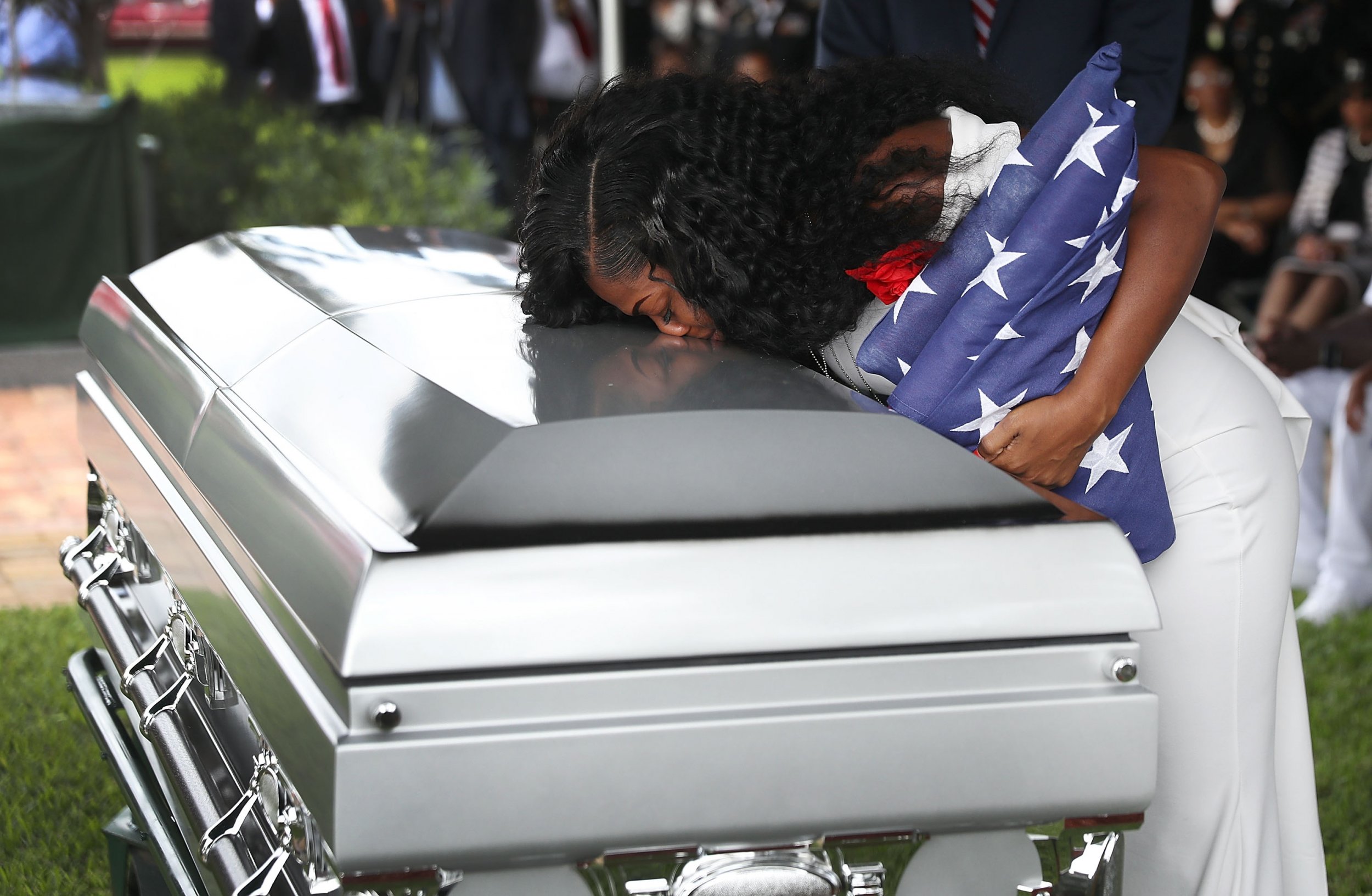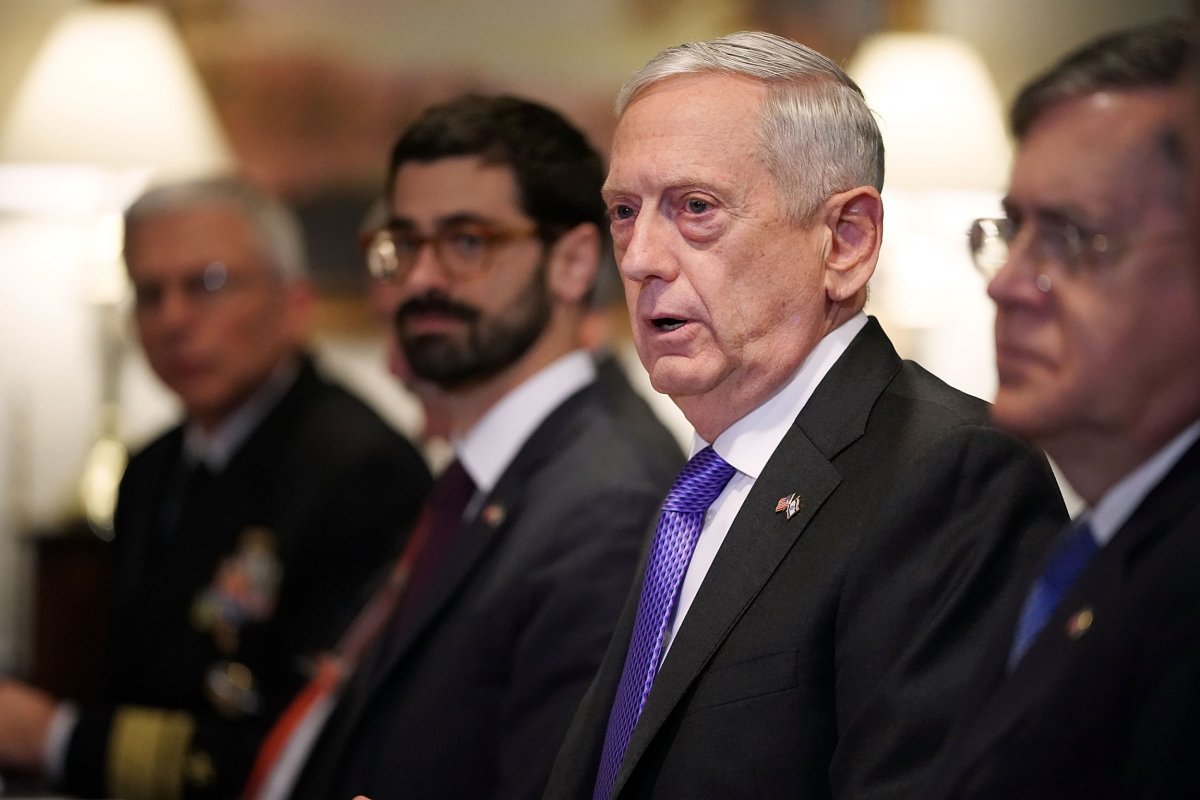
For weeks, details about the October 4 assault on a joint U.S.-Nigerien patrol in the West African country of Niger have not been fully disclosed.
But information has slowly been emerging from the White House and the Pentagon as pressure has mounted for full transparency about the events that led to the death of four U.S. soldiers: Staff Sgt. Dustin Wright, 29; Sgt. La David Johnson, 25; Staff Sgt. Bryan Black, 35; and Staff Sgt. Jeremiah Johnson, 39.
A more detailed picture of the events in and around the village of Tongo-Tongo on that day has started to emerge, and the decisions that led to the ambush by radical Islamist militants on these men is becoming clearer, albeit not completely.
As the investigation into the attack continues, and as Defense Secretary James Mattis and top Republican lawmakers such as Senator John McCain demand answers, here's what we know, and what is still unclear, about the Niger ambush.
What We Know
The Mission
The patrol, comprised of 11 Americans from the U.S. Army Special Forces Task Forces, their interpreter and 30 Nigerien soldiers, was initially reported to be meeting with village elders in Tongo-Tongo on a routine visit in a location deemed to have sympathies with the Islamic State militant group (ISIS).
But it has emerged that the patrol had another purpose: supporting the search for a high-value militant operating in the area, near the Malian border. The unit began its mission overnight on October 3 and in the early hours of October 4, reached the campsite of the target, north of Tongo-Tongo; he was not found. The unit burned the campsite down, U.S. officials told ABC News.
Another group of special forces was to launch a raid, on a mission code-named Obsidian Nomad, to capture or kill the target from helicopters, based on intelligence that the target was in the area, officials told The New York Times. But bad weather put an end to their role, leaving the second group tasked with collecting evidence of the target's presence in the region. The military referred to the target as Naylor Road.
It was in the hours afterward that the unit passed through the village, stopping to speak to elders and to rest.
The Target
The target is believed to have been the leader of a local ISIS affiliate, the Islamic State in the Greater Sahara (ISGS): a jihadi known as Adnan Abu Walid Al-Sahraoui, sources told CBS News. U.S. forces had received intelligence that the target, believed to be Al-Sahraoui, was operating near the Malian border but crossed into the neighboring country before the mission was launched, a U.S. military official told the broadcaster.
Other accounts, including one from Reuters dated October 6, suggest that the target may have been a lieutenant in Al-Sahraoui's inner circle, Dondou Chefou, and his unit. But Chefou is reported to have led the ambush on the U.S.-Nigerien patrol, meaning he would not have been the target that crossed into Malian territory.
Al-Sahraoui once led the Al-Qaeda-aligned Movement for Oneness and Jihad in West Africa (MUJAO) before pledging allegiance to ISIS leader Abu Bakr al-Baghdadi. He is the top ISIS leader in the Sahel, one who has called for attacks on Westerners in Morocco.
Video footage shot before the attack shows armed men discussing their targets and what they would do to them. The footage was obtained by retired Lieutenant Colonel Rudolph Atallah, a former U.S. military official in West Africa. He told ABC News that it was likely shot by the suspected target of the mission, Al-Sahraoui.
The Setup
When the soldiers arrived into Tongo-Tongo, a village elder attempted to delay the unit, they believed, continuing to talk so they would not leave the village. The militants were likely tipped off by at least one sympathizer who may have lived within the local population, U.S. and local officials believe.
Almou Hassane, the mayor of Tondikiwindi, which includes Tongo-Tongo, told Voice of America that "the attackers, the bandits, the terrorists have never lacked accomplices among local populations."
When the men finally left the town at around 11.40 a.m. local time, they were attacked by militants armed to the teeth with small arms, mortars and rocket-propelled grenades. As many as 50 fighters had launched the ambush, outnumbering the group.
The Men Called for Help, Became Separated
Between one and two hours after the ambush and ensuing firefight began, the unit called for air support. French Mirage jets flew overhead to ward off the jihadis; a U.S. drone arrived within minutes but did not fire. None of those actions stopped the attack.
The four U.S. soldiers who died became separated from the main group, officials told the Times. When French helicopters arrived to pick up the American members of the unit, they collected all but four men: those who died. The four were deemed to be missing in action, and the helicopters flew off without them.
The Death Toll
The bodies of three of the U.S. soldiers were found and retrieved in the hours following the firefight. But two days would pass before the body of Sargent La David T. Johnson was discovered. French, Nigerien and U.S. troops all conducted a mass search for his body before the Nigeriens discovered it in woodland near the site of the attack.
Five Nigerien soldiers also died in the ambush.
The Group Responsible
The working assumption of the U.S. military is that the ISIS affiliate in the region, ISGS, was behind the attack. Al-Qaeda-aligned groups operate in the Sahel but affiliate leader al-Sahraoui was the target of the mission, and one villager in Tongo-Tongo reportedly told the soldiers that an important ISIS emir, who officials also suspect had sympathies with the radical Islamist group, was in the vicinity of the village.
Neither ISIS nor Al-Qaeda have claimed the attack.
Despite the lack of concrete evidence or claim from the group, Joint Chiefs Chairman General Joseph Dunford said Monday the Pentagon believes "an ISIS-affiliated group" was responsible for the attack.

What We Don't Know
Many questions remain unanswered about the attack and the events on October 4. Here are some of the facts that are yet to be determined or publicly disclosed by U.S. military officials.
Why French Helicopters Did Not Rescue the Four U.S. Soldiers
If the accounts of officials are to be believed, French helicopters left with several U.S. soldiers, but possibly left behind the four men who became separated from the group and were subsequently killed.
The French air forces may have decided to prioritize getting the seven U.S. personnel who had been found back to safety rather than risk any more casualties, but the rationale for any such decision, and what was known to both U.S. and French military officials at the time, remains unclear.
The prospect that the men were still alive when the helicopter departed remains unanswered, but their loved ones and top politicians will want to know if these men really were left behind. If this turns out to have been the case, it would contradict Mattis's claim that "the U.S. military does not leave our troops behind."
Why the U.S. Drone Did Not Fire
Dunford told reporters Monday that a U.S. drone arrived "within minutes" of support being requested. It provided surveillance of the area of the ambush but it did not fire. Dunford would not say whether the drone was armed or not. But Niger has not permitted the American military to arm its drones for use in the country against radical Islamists.
As it emerged this week that the Trump administration has been lobbying for the arming of drones in the country, questions will be asked if enough has been done to protect U.S. soldiers operating on the ground in the Sahel, where jihadis operate with relative impunity.
Similarly, French Mirage jets buzzed over the battlefield but did not strike because they were not in close contact with their American counterparts and could not identify the forces to be targeted; they did not want to risk potentially striking friendly U.S. and Nigerien fighters.

Why It Took Two Days to Find Johnson's Body
The body of Johnson, a 25-year-old mechanic, was left behind and not recovered for two days. It led to a frantic search for the soldier after he was declared a DUSTWUN, or "duty status whereabouts unknown," for fear that jihadis would either keep his remains or be holding him hostage. To this end, the Pentagon dispatched elite commandos in a bid to find him and prevent him falling into enemy hands, ABC News first reported.
Johnson's body was found in the vicinity of the ambush, and the other slain soldiers who had become separated were found within hours. The time it took to find his body—more than 48 hours—opens up the possibility that he could have been alive for hours, if not a day, before succumbing to his wounds, and that his life could have been saved had he been discovered earlier. He was only discovered by local Nigeriens, who then turned his body over to Nigerien forces working with the U.S. military.
So the military will need to answer to the family of Johnson as to why it took so long for the militaries of three nations to find him, and explain to top lawmakers and other military officials why a soldier was left on the battlefield for so long.
Why the Pentagon Was Surprised by the Attack
Joint Staff director Lieutenant General Kenneth Mckenzie said last week that the patrol was embarking on a common reconnaissance mission, one that had not met any hostile forces in six months (Green Berets have made the journey to the Niger-Mali border on 29 occasions in that time), and therefore there was no evidence that an attack was forthcoming.
Nevertheless, the U.N. has documented dozens of attacks in the region since the beginning of 2016.
In the districts around Tongo-Tongo, at least 46 attacks have taken place since February 2016 by armed groups. Seven departments in the districts of Tahoua and Tillaberi, where Tongo-Tongo is located, had been placed under a state of emergency because of the threat of attacks, the U.N. Office for the Coordination of Humanitarian Affairs disclosed to BuzzFeed News. This revelation appears to contradict the Pentagon's assessment of Tongo-Tongo as a low-risk area.
McCain, after a briefing on the ambush Thursday, echoed this sentiment. "What was the strategy?" he asked. "Why were we surprised? There's a hundred questions that need to be answered."
Why ISIS Has Not Claimed the Assault
The Pentagon is adamant that the ambush was conducted by ISIS-aligned fighters. ISIS has accepted the bayah, or pledge, of the ISGS, but has not recognized its involvement in this assault.
The militant group has a history of not claiming attacks when the perpetrators remain alive—although it recently changed its position on this, claiming attacks such as the Parsons Green tube bombing in London last month, in which the perpetrator remained alive.
The group's involvement therefore remains unclear, and its unwillingness to take responsibility for the deaths of four U.S. soldiers, when it claimed the Parsons Green bombing, which resulted in no fatalities, perplexes observers and experts alike.
Uncommon Knowledge
Newsweek is committed to challenging conventional wisdom and finding connections in the search for common ground.
Newsweek is committed to challenging conventional wisdom and finding connections in the search for common ground.
About the writer
Jack is International Security and Terrorism Correspondent for Newsweek.
Email: j.moore@newsweek.com
Encrypted email: jfxm@protonmail.com
Available on Whatsapp, Signal, Wickr, Telegram, Viber.
Twitter: @JFXM
Instagram: Read more
To read how Newsweek uses AI as a newsroom tool, Click here.








